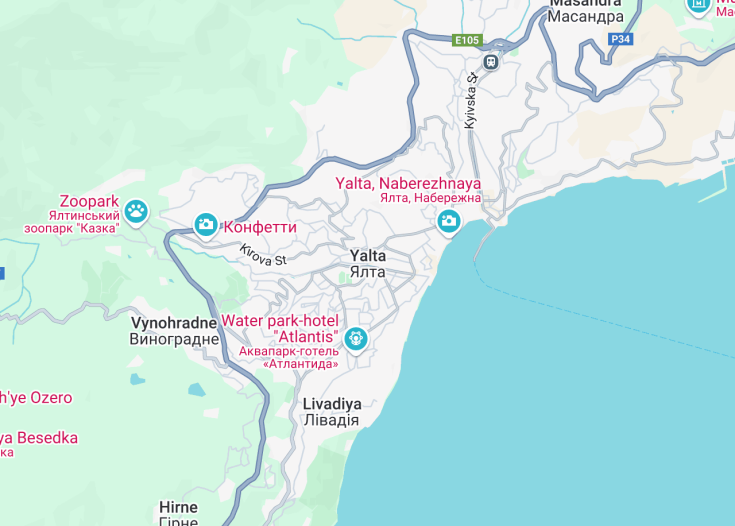Yalta, nestled on the picturesque southern coast of the Crimean Peninsula, presents a unique blend of historical richness and natural beauty. This illustrious resort town is famed for its favorable subtropical climate, lush vegetation, and panoramic views of the Black Sea. Yalta’s storied past, highlighted by the seminal Yalta Conference of 1945, adds a profound historical significance, making it as educative as it is relaxing. The town offers an array of architectural landmarks, from the Tsar’s former summer palace to an assortment of ornate 19th-century mansions, making it a captivating destination for history buffs and nature lovers alike.
Before visiting, explore options for guided tours to maximize understanding of Yalta’s rich historical context and architectural treasures.
Consider visiting during late spring or early autumn to enjoy Yalta’s attractions with milder weather and fewer tourists.
Top things to do & see in Yalta
Select the following sights and activities to discover best tickets and tours available in Yalta.
Yalta: A Gem on the Black Sea
| Country | Ukraina |
| Time in Yalta | GMT+3 |
| Language spoken | Russian |
| Population | 76,746 (according to the 2020 census) |
| Currency | Ukrainian Hryvnia (₴, UAH) |
| Airports |
|
Yalta, nestled on the southern coast of the Crimea peninsula, holds a prominent place in both Ukrainian and Russian history. Renowned for its temperate climate and stunning sea vistas, Yalta has been a favored resort since the 19th century, drawing visitors from across Europe and beyond. Its picturesque landscapes are dominated by rugged mountains that plunge down to a beautiful coastline studded with pebbly beaches and old-world promenades.
The city’s history is rich with cultural and political significance, primarily marked by the Yalta Conference in 1945 where Roosevelt, Churchill, and Stalin shaped post-war Europe. Amidst its political heritage, the city is also known for its literary connections. Anton Chekhov wrote some of his famous works here, his house now a dedicated museum. Additionally, Yalta’s palaces—such as the Italianate Livadia Palace and the neo-Gothic Swallow’s Nest—mirror its role as a playground for tsars and aristocrats of bygone days.
Yet, its historical allure blends seamlessly with modern attractions. Visitors can explore diverse botanical gardens, engage in various water sports, or unwind in sea-facing cafés. The cable car journey to Darsan Hill offers panoramic views of the city’s tapestried layout against the azure Black Sea. Furthermore, Yalta serves as a gateway to exploring the broader Crimean landscapes, with ecotours and hiking trails in the nearby Crimean Mountains.
With a unique blend of natural beauty, historical depth, and modern charm, Yalta remains a fascinating destination for travelers seeking both relaxation and enrichment.
Where is Yalta?
Yalta is located on the southern coast of the Crimea peninsula, facing the northern Black Sea.
Distances:
| Route | Distance by car | Time by car |
|---|---|---|
| Kyiv to Yalta | 615 miles (990 km) | Approx. 12 hours |
| Odessa to Yalta | 385 miles (620 km) | Approx. 8 hours |
What is Yalta famous for?
Yalta is famous as a historic resort city known for its picturesque seafront, the Yalta Conference during WWII, and its storied past featuring figures like Chekhov and Tsarist royalty.
History
Write the history of Yalta in Ukraina, from the first inhabitants, foundation or discovery to the present day, creating sub-sections with h4 titles of the different historical periods. Each title will start with the time span. Important: insert “
Visit Yalta
What to see and do in Yalta, Ukraina.
Yalta, nestled on the picturesque coast of the Black Sea in Ukraine, offers a unique blend of historical architecture and natural beauty. Visitors can explore the Livadia Palace, the former summer retreat of the last Russian tsar, Nicholas II. The Yalta Conference of 1945, where leaders like Churchill, Roosevelt, and Stalin discussed post-war Europe, took place here. The surrounding Livadia Park is ideal for leisurely strolls amongst native and exotic plants.
For natural attractions, the Nikita Botanical Gardens display a diverse collection of flora and a serene place for relaxation. Hiking enthusiasts can venture into the nearby Crimean Mountains, offering breathtaking views and paths suited for various skill levels. Not to be missed, the Yalta seafront promenade is perfect for a gentle walk along the coast, with numerous cafes and restaurants offering local and international cuisine. The cable car to Darsan Hill, provides panoramic city and sea views.
Cultural Events in Yalta
Yalta is vibrant with cultural events throughout the year. The Yalta Summer Film Festival, held annually in July, showcases international and Ukrainian films and promotes local cinematic talents. In September, the city celebrates the Yalta Vintage Festival, a homage to the region’s wine-making traditions where visitors can taste local wines and learn about the wine-making process.
The Yalta European Strategy Meeting, also in September, gathers leaders and influential figures to discuss Ukraine’s European integration and global issues.
Best time to visit Yalta
The best time to visit Yalta is from late spring through early autumn, particularly between May and September. During this period, the weather is most favorable with warm temperatures and low rainfall, ideal for exploring the outdoor attractions and enjoying the beaches. Summer months, while warmer, can also be crowded; visiting in late spring or early autumn can provide a more relaxed experience with milder weather.
Is Yalta worth visiting?
Yalta offers a rich tapestry of historical, cultural, and natural attractions that make it a worthwhile destination. Its beautiful seafront, historical sites like the Livadia Palace, and the lush, mountainous surroundings offer a diverse experience.
However, visitors should be aware of the potential for crowded conditions during peak tourist season in the summer months. Additionally, ongoing political tensions in the region may pose challenges. Despite these factors, Yalta’s unique charm and historical significance provide compelling reasons for a visit, especially for those interested in history and nature.










